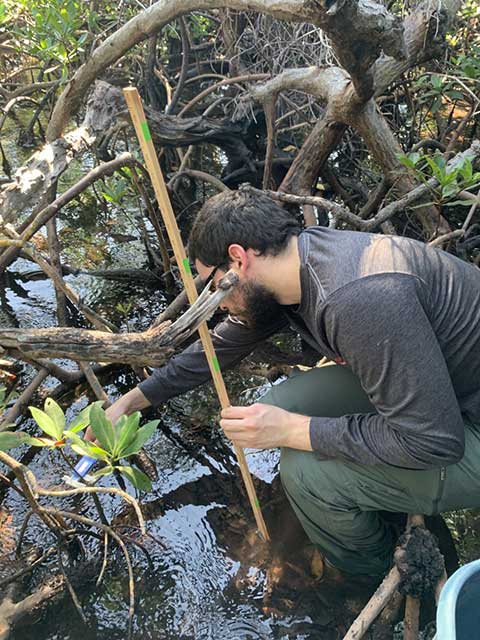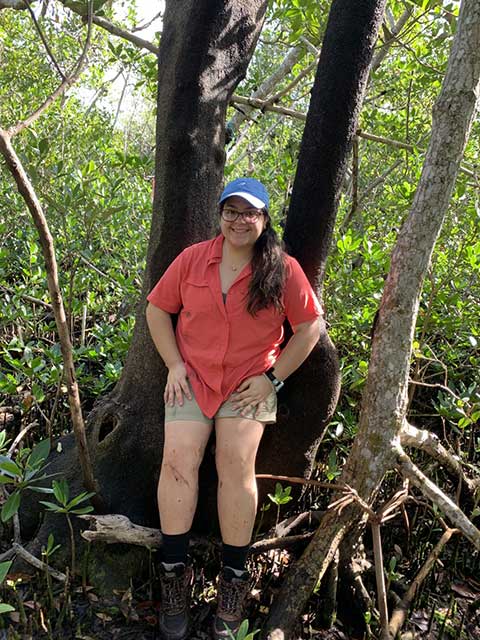Florida Gulf Coast University Professor Win Everham partnered with senior biology majors Paola Reyes and Jose Rivera on a research study deducing the effects of human development on mangroves in Florida.
The research team measured the growth of mangroves under different conditions: natural growth, natural storm restrictions, and restrictions from human development. Mangroves are trees or shrubs that live along shores, rivers and estuaries in the tropics and subtropics; they commonly grow on the banks of south Florida’s estuaries and are also extremely important to ecosystems.

Mangroves play an important part as a first line of defense against storms, hurricanes, waves and floods. They also prevent erosion and provide stability and shelter to ecosystems and aquatic life. Lastly, they also act as a natural filtration system, restraining sediments and other land runoffs that could damage water quality.
For these reasons, Reyes, Rivera and Everham chose to study the impacts of human development on the growth of mangroves. They theorize that man-made structures such as roads and bridges can interfere with the waterflow that nurtures mangrove growth and are leading to irregular forms of the shoreline plants.
Biology students turned researchers
At FGCU, it’s not unusual for undergraduates to collaborate with faculty on research. In fact, it’s encouraged. Nevertheless, Reyes and Rivera’s path to the project was far from usual, and they are grateful for the experience and the chance to work with Everham.
Three years ago, Reyes and Rivera couldn’t have foreseen themselves graduating from FGCU, as they did this spring, let alone researching mangroves. Before Hurricane Maria made its mark as one of history’s most devastating storms, both were living in Puerto Rico, one of the areas decimated by the 2017 hurricane.
Reyes was there finishing her bachelor’s degree when the hurricane landed. As the storm’s aftermath wrecked the way of life on the island, Reyes decided to move in with her parents in Fort Myers. Rivera also moved here after his education was disrupted by the hurricane. Both took advantage of FGCU’s gracious initiative to offer in-state tuition to students displaced from Puerto Rico by the hurricane.
Expectedly, it took Reyes and Rivera a little while to settle in comfortably at their new home, but that’s exactly what they found at FGCU: a home.
“I didn’t think about the cultural difference. I literally took my stuff, put on a backpack, and got on a plane and came here,” said Reyes. “I was just a random transfer student, so I had to live by myself. But the resources and the people that were willing to help me here, especially the professors, made the transition a lot easier. I’ve been having a great experience here.”
Rivera echoed her thoughts. While the two eventually were able to find a home here, they still needed to secure a senior research study in order to secure their degrees and graduate.
Everham saved the day. Reyes and Everham had partnered before, on the “Voice Boricuas” documentary highlighting Puerto Rico’s hurricane recovery efforts that debuted earlier this year. Reyes asked Everham about ideas for her senior research project, and Everham suggested following up on a previous mangrove project he’d done with FGCU graduate student Gianna Diaz.
Rivera wasn’t particularly interested in mangroves at first but became more engaged the deeper they got into the study. “We went into the field with him and that’s where our interest came up,” he said. “It’s something else, seeing his passion about all that he’s doing. And then he transmits that passion into you.”
Everham’s enthusiasm for science inspired his student researchers, and they have nothing but pride and gratitude to have the opportunity to work in the field with him.

“It has been an amazing journey. He’s been an amazing mentor,” said Reyes. “I personally feel that he has become a friend, someone that’s going to be there for whatever you need.”
“He’s always there for you, like he cares about you,” said Rivera. “He shows that he is genuinely interested in and cares about his students.”
Developing a research method
The team tested their hypothesis by studying the growth of mangroves in three local bodies of water with various tidal conditions. By measuring different stages of growth of mangroves in these areas, the team can then assess how storm and human factors are affecting the plants.
The three areas tested were Big Hickory Island, the shores along Bonita Beach Road and FGCU’s Vester Marine & Environmental Science Research Field Station. Big Hickory Island has seen significant storm damage that has led to debris interrupting the water flow from naturally reaching the mangroves along the banks. Therefore, the mangroves may indicate changes in growth as a result of storm restrictions. In contrast, Bonita Beach Road holds a lot of commercial development, roads, bridges and piers that restrict water flow. Changes in the mangrove growth along Bonita Beach Road would identify the effects of land development on the plant life. The mangroves at Vester serve as the control group, as the growth of the mangroves there are unimpeded by either storm damage or man-made structures.
“It’s not a trivial thing to ask, ‘How do you measure mangrove seedlings,’” said Everham. “They had to go into the literature and find out how others have done this. And it turned out to be different for different species (of mangroves). So, they had to come up with a standard way of measuring the seedling diameter.”
The team measured the differences in seedlings of the mangroves in the three locations, each with different circumstances affecting their development. With those measurements, they were able to conclude their study and presented their results at FGCU’s Research Day.
Results and future implications
The team found some interesting results in their research study. In the red mangroves examined by the team, they found statistically significant variation in growth when faced with restrictions.
But the results across the board were too inconsistent to conclude definite results from growth restrictions.
“We didn’t find a consistent pattern for seedling morphology across all sites and species,” Reyes said. “The red mangroves had the strongest difference among the sites, with shorter and fatter seedlings at Big Hickory Island. The sites we visited didn’t have a traditional pattern for mangrove zonation.”
But the results were significant enough for Reyes and the team to plan further research.
“For future studies, we want to expand the sampling sites, and possibly quantify the tidal restriction,” she said.